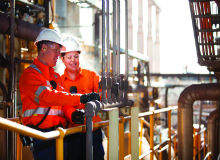

Following their signing of the Japan-Australia Economic Partnership Agreement (JAEPA), Australian Prime Minister Tony Abbott and his Japanese counterpart Shinzo Abe expressed their delight with the negotiations, with the consensus being that both sides are more than happy with their respective outcomes.
Coming into effect on 15 January, JAEPA attempts to signal a new era between the two economic heavyweights.
While it covers a vast range of sectors – Japan is Australia’s second-largest trading partner behind China – one area where the agreement could have a profound effect is the minerals and mining industry.
It will ensure that more than 97% of Australia’s exports to Japan will enter the country duty-free or, failing that, receive preferential access. Tariffs will also be eliminated on Australia’s minerals, energy and manufacturing exports, with similar agricultural tariffs reduced for a range of products.
According to the Australian Department of Foreign Affairs and Trade (DFAT), JAEPA will give Australian service providers outcomes that are at least equal to those Japan has made in other trade agreements, and promote Japanese investment in Australia by increasing the Foreign Investment Review Board threshold for private Japanese investment in non-sensitive sectors.
Liberating trade
In terms of investment in Australian mining operations, Japan is the third-largest contributor. Noting the importance of the relationship, Abbott said last year during a visit with Abe to an open-pit mine at Rio Tinto’s West Angelas site in the Pilbara region that "almost nothing here in the Pilbara would have happened without the cooperation of Australia and Japan".
Australia has a legacy of abandoned mines which, due to fragmented initiatives and a lack of funds, are not being rehabilitated.
Abe added: "Ever since the 1950s, with Japanese investment, Western Australia has been developing mineral resources and, of course at the other end with the supply of resources and energy from Australia, it has been an important part of Japanese economic growth."
Digging deeper into the specifics, the 3.2% tariff on titanium dioxide pigment – which is used to add brightness and durability to a range of products – has been removed. Exports of this were worth A$15m in 2013. Quoted on the DFAT website, Alan Bassham, manager of MPS Inventory and Logistics Asia Pacific at Tronox Limited, which has operations in Western Australia, said decisions such as these strengthen the company’s competitiveness in the Asia-Pacific economy.
Commenting on the agreement, the Minerals Council of Australia (MCA) – whose members make up more than 85% of Australia’s annual mineral production – said it will help integrate the country within the Asia-Pacific region, fight off competition from other players in the market – particularly Indonesia for thermal coal and Brazil’s iron ore suppliers – and engender additional two-way investment.
This investment sees Japanese companies pumping more of their money into Australian mining than they do in any other country – eight times more than the rest of Asia.
Scott Barklamb, Australian Mines and Metals Association (AMMA) executive director of Policy and Public Affairs, agrees with the premise that JAEPA helps position Australia above its competitors, labelling it "historic". He says: "The Australian resource sector operates in a fiercely competitive international market.
"It will make Australian resource exports more competitive and attractive to Japan, compared to our export competitors that do not have an equivalent FTA with Japan."
"The FTA is of tactical and strategic importance," Barklamb continues. "Given the current state of the economy and the falling index of commodity prices – one factor has to do with rising supply levels causing supply gluts in many commodity markets – any competitive advantage, or levelling up of any playing field … is welcomed."
Demand for coal: a strong driver of Australia’s export revenue
From a Japanese point of view, more than 60% of their coal imports and almost 60% of iron ore imports are from Australia, further underlining the scale of the relationship. Added to this, according to figures on the Austrade website, resources and energy totalled 85% of exports to Japan during 2013 and 2014, and in 2013 alone Australia was responsible for exporting more than A$130m of coke and semi-coke of coal to Japan.
"Japanese demand for coal, iron ore and natural gas has been a strong driver of Australia’s export revenue and economic prosperity," adds Barklamb, with the 2012 to 2013 financial year producing A$36.2bn worth of trade in these commodities.
Likewise, Chris Salisbury, Rio Tinto Coal Australia managing director, referenced Japan’s thirst for coal when news of JAEPA broke. "Rio Tinto is very aware that coal markets are driven by demand for both the quantity and quality of coal, and that Japan will remain a constant source of demand for high-quality coal," he was quoted as saying on the DFAT website.
"In this way, the long-term relationships our business holds with customers and joint venture partners in Japan are a central part of our strategies for the future."
‘A significant milestone’
The MCA and Barklamb are united in the belief that JAEPA is the natural successor to the 1957 Australia-Japan Commerce Treaty, with Barklamb adding that it represents a "significant milestone" for the country’s national resource industry.
Looking ahead, Barklamb expects LNG, iron ore and coal to be the chief growth areas. Predictions from AMMA conclude that the Australian resource sector could conceivably total 67% of mining sector revenue between 2014 and 2015.
With the elimination of tariffs on resource exports worth approximately A$300m, the raw figures suggest that JAEPA is good news for business, ensuring that all parties can extract as much as possible from the two-way relationship.
While putting this into practice may yet prove difficult, the reaction from the mining industry is one of warm applause.


.gif)

